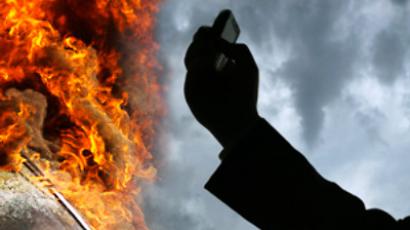How can I help you and film you at the same time?
Car crashes are common enough, but there's a growing trend for witnesses to film accidents on their mobile phones rather than help out. A recent gruesome incident in Central Russia, has sparked debate about the issue.
A passenger and a driver are trapped inside a burning car. Stunned by the scene, a passer-by films the crash. A minute passes. Someone manages to rescue the driver. But the volunteer cameraman keeps shooting the scene.
Two more minutes – the car turns into a fireball, killing the passenger.
It was Sergey Novoselov who recorded the footage. He said he thought no one in the car would survive, so he continued filming instead.
“I saw fire, I started filming it, and when I saw the victims, there was no thought to turn the camera off. I was so shocked at the moment,” Sergey told RT.
He says he wanted to sell the video to TV shows, but he also posted it on the internet.
On youtube alone, there are more than 10,000 car crash videos: 3, 500 of these were uploaded by Russian users. As most cell phones are equipped with a camera, sometimes all it takes to become a reporter is to point and shoot.
Internet professionals say the ratings for eyewitness videos of this type are sky-high. The content often sparks heated debate in online forums.
So, in the aftermath of gruesome accidents, why is it that some people prefer to watch rather than help?
Criminal psychologist Aleksey Vinogradov says it’s a remarkably common trait:
“Only one out of every ten people is capable of coming to the rescue. There are also the indifferent, and the timid, and of course there are the ones who enjoy seeing somebody else’s suffering.”
For his part, psychologist Dr. Gio di Feo links the increased violence and indifference to life in a megapolis, in which compassion is becoming extinct:
“No more compassion, which means “suffering together” in Latin. We live in small families in big cities, we’ve lost our sense of common living. In big cities nobody is connected,” he believes.
While the only survivor of the car crash remains in hospital, Sergey and his friends – who were with him at the time, and also failed to help – are now frequent guests on TV shows.
The case has sparked a public debate on whether passers-by should be held accountable for not helping victims.
There’s no legal obligation in Russia to provide assistance. But for many people, using common sense and compassion are the best ways to respond to an emergency.












